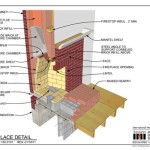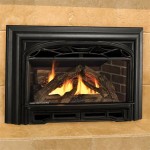Understanding Zero Clearance Fireplaces
A zero clearance fireplace, also known as a factory-built fireplace, is a self-contained heating appliance designed to be installed directly into combustible materials without requiring extensive masonry work. This distinguishes them from traditional masonry fireplaces, which necessitate a significant air gap and non-combustible construction around their firebox and chimney to prevent fire hazards. Zero clearance fireplaces are designed with insulated fireboxes and air-cooling systems that allow for safe installation with minimal clearances to nearby walls, floors, and ceilings composed of wood and other flammable materials.
The term "zero clearance" refers to the minimum allowable distance between the firebox and adjacent combustible framing. While the name implies no clearance at all, most manufacturers specify a small, but still greatly reduced, clearance requirement compared to conventional fireplaces. These requirements are rigorously tested and certified by independent testing agencies like UL (Underwriters Laboratories) or CSA (Canadian Standards Association). Proper installation adhering to the manufacturer's guidelines and local building codes is paramount for safe and efficient operation.
Zero clearance fireplaces offer a versatile and cost-effective alternative to masonry fireplaces. They are available in a wide range of styles, sizes, and fuel types, including wood-burning, gas, and electric models. This makes them suitable for various architectural designs and heating needs. Their relative ease of installation, compared to masonry fireplaces, also contributes to lower overall project costs.
Key Point 1: Design and Construction
The core of a zero clearance fireplace lies in its engineered design and construction. The firebox itself is typically constructed of heavy-gauge steel or cast iron, providing a robust and durable enclosure for the fire. This firebox is then surrounded by multiple layers of insulation, often including ceramic fiber blankets or air-cooled cavities. These insulation layers are crucial for reducing the external surface temperature of the fireplace, allowing it to be safely installed in close proximity to combustible materials.
The outer shell of the fireplace is typically made of steel and finished with a decorative facade. This facade can be designed to mimic the appearance of a traditional masonry fireplace, with options for brick, stone, or other aesthetically pleasing materials. The design also incorporates a venting system, which is essential for safely exhausting combustion gases and ensuring proper airflow within the firebox. The venting system is typically a double or triple-walled pipe specifically designed for use with zero clearance fireplaces.
The air-cooling system is a critical component of zero clearance fireplaces. This system typically involves circulating air between the firebox and the outer shell of the fireplace. This air circulation helps to dissipate heat and maintain a safe surface temperature on the exterior of the unit. The air circulation can be achieved through natural convection or with the assistance of a blower fan, depending on the model and manufacturer's design.
Many zero clearance fireplaces include features like adjustable air controls, which allow the homeowner to regulate the intensity of the fire and the rate of combustion. Some models also incorporate catalytic combustors, which help to reduce emissions and improve the efficiency of the burning process. These features contribute to both the environmental performance and the user experience of the fireplace.
Key Point 2: Fuel Types and Efficiency
Zero clearance fireplaces are available in several fuel types, each offering distinct advantages and disadvantages. Wood-burning models are a popular choice for those seeking the traditional ambiance and heat output of a real wood fire. Gas models offer convenience and ease of use, with instant ignition and adjustable flame height. Electric models provide a purely aesthetic experience, with realistic-looking flames and adjustable heat output, without the need for venting or fuel storage.
Wood-burning zero clearance fireplaces typically have higher heat output than gas or electric models. However, they also require more maintenance, including wood storage, ash removal, and chimney cleaning. Gas zero clearance fireplaces offer a cleaner and more convenient alternative to wood-burning models, with lower emissions and less maintenance. Electric zero clearance fireplaces are the most convenient option, requiring no fuel storage or venting, but they typically provide less heat output than wood or gas models.
The efficiency of a zero clearance fireplace depends on the fuel type, the design of the firebox, and the venting system. Wood-burning models generally have lower efficiency ratings than gas or electric models. Gas models can achieve higher efficiency ratings with features like sealed combustion chambers and electronic ignition systems. Electric models are the most efficient, as they convert virtually all of the electricity they consume into heat.
When selecting a zero clearance fireplace, it is important to consider the fuel type, the heat output, and the efficiency rating. The choice will depend on the homeowner's individual needs and preferences, as well as local building codes and environmental regulations. Factors such as fuel availability, cost, and maintenance requirements should also be taken into account.
Key Point 3: Installation and Safety
Proper installation is crucial for the safe and efficient operation of a zero clearance fireplace. Installation should always be performed by a qualified and experienced professional who is familiar with local building codes and manufacturer's instructions. Failure to follow the proper installation procedures can result in fire hazards, carbon monoxide poisoning, and other serious risks.
The installation process typically involves framing the fireplace opening, installing the venting system, and connecting the fuel supply (for gas models). The framing must be constructed according to the manufacturer's specifications, ensuring that the required clearances to combustible materials are maintained. The venting system must be properly installed and sealed to prevent leaks and ensure proper draft. The fuel supply must be connected by a licensed gas fitter, ensuring that all connections are leak-free and properly regulated.
Regular maintenance is also essential for the safe and efficient operation of a zero clearance fireplace. Wood-burning models require regular chimney cleaning to remove creosote buildup, which is a highly flammable substance that can cause chimney fires. Gas models require periodic inspection and cleaning of the burner assembly and venting system. Electric models typically require minimal maintenance, but should be inspected regularly for any signs of damage or wear.
Carbon monoxide detectors should be installed in all homes with zero clearance fireplaces, regardless of the fuel type. Carbon monoxide is a colorless, odorless gas that can be deadly. Detectors provide an early warning of dangerous levels of carbon monoxide, allowing occupants to evacuate the premises before serious health problems occur. It's crucial to test and maintain the carbon monoxide according to the manufacturer’s instructions.
Furthermore, it is important to use only the type of fuel recommended by the manufacturer. Burning unauthorized materials, such as treated wood or plastics, can release harmful toxins into the air and damage the fireplace. Adhering to the manufacturer's recommendations for fuel usage is critical for extending the lifespan of the appliance and ensuring safe operation. Homeowners should familiarize themselves with the owner's manual and follow all safety guidelines provided.
Finally, it's vital to ensure that the fireplace is inspected regularly by a qualified technician. An annual inspection can identify potential problems before they become serious, helping to prevent costly repairs and ensure the continued safe operation of the fireplace. Inspections are particularly important for gas and wood-burning models, as they involve more complex components and potential safety hazards.

Is A New Zero Clearance Fireplace Right For You Design Styles Sizes

Fireplace Insert Vs Zero Clearance Maple Mtn

Epa Certified Zero Clearance Wood Burning Fireplaces
.aspx?strip=all)
Zero Clearance Fireplaces Explained Regency Fireplace S

Zero Clearance Vs Prefabricated Fireplace Full Service Chimney

Zero Clearance Fireplaces Gas Wood

Renaissance Rumford L50 Linear Woodburning Zero Clearance Fireplace Fergus

Rsf Pearl Woodburning Zero Clearance Fireplace Fergus

Do You Have A Masonry Or Zero Clearance Fireplace

Zero Clearance Wood Fireplace Z42 Z42cd Kozy Heat
Related Posts








